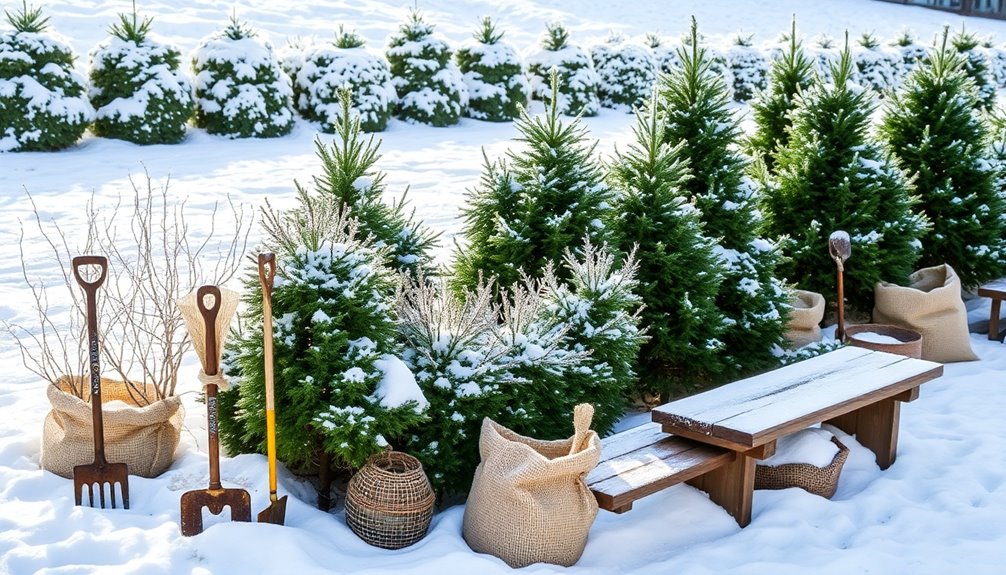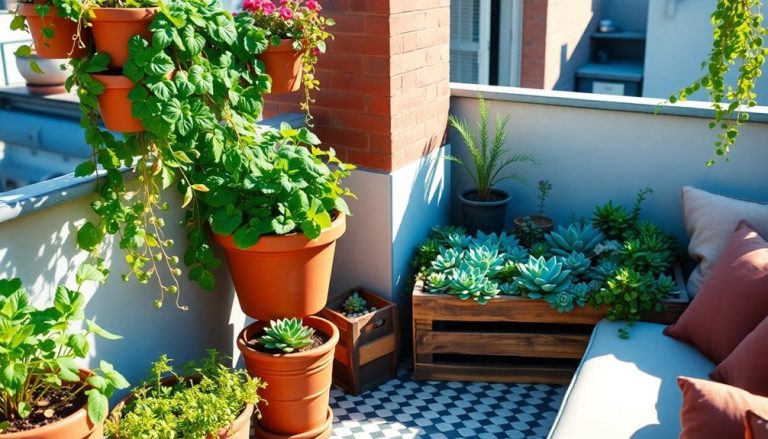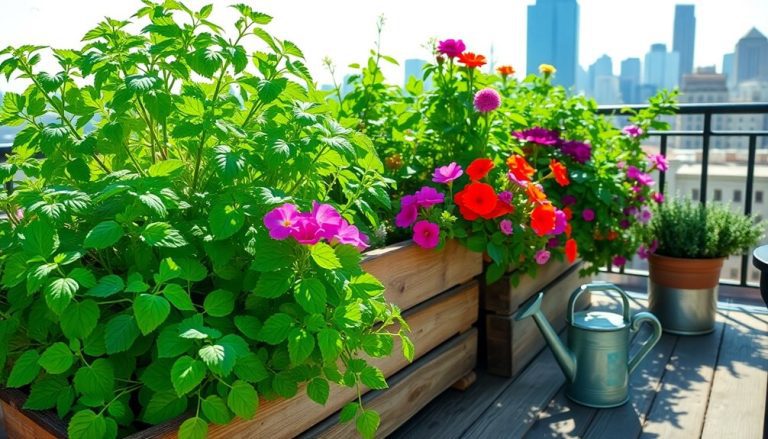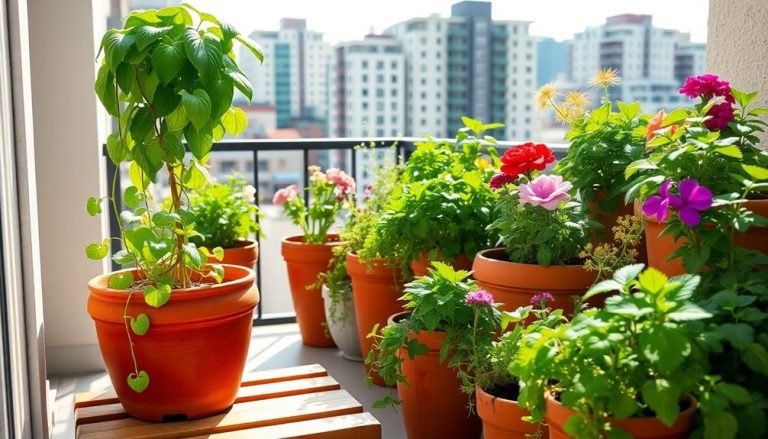To keep your garden thriving through winter, start by assessing your plants for health and removing any dead foliage. Apply a thick layer of mulch to insulate soil and maintain moisture. Protect sensitive plants by wrapping them in burlap or moving pots to sheltered spots. Trim any dead branches to encourage healthy growth. Test your soil pH and nutrient levels, adding organic matter as needed. Regularly check for dormant pests and implement organic pest control methods. With these steps, you're setting the stage for a vibrant spring garden. Discover more ways to enhance your garden's winter care.
Key Takeaways
- Assess your garden's needs by evaluating plant health, soil pH, and nutrient levels to prepare for spring growth.
- Apply a thick layer of organic mulch to insulate soil, maintain moisture, and regulate temperature during winter.
- Protect sensitive plants by wrapping them in burlap, using frost cloths, or moving potted plants to sheltered locations.
- Regularly prune dead or damaged branches from trees and shrubs to promote healthy growth and prepare for the new season.
- Inspect for winter pests and use organic treatments like insecticidal soap or neem oil to manage any infestations.
Assess Your Garden's Needs

Before winter sets in, it's crucial to assess your garden's needs. Start by evaluating the health of your plants. Look for any signs of disease or pests that could affect their survival during the colder months. Remove any dead or dying foliage, as this can harbor pests and diseases over winter.
Next, consider the soil. Test its pH and nutrient levels to ensure it's ready for spring planting. Amending your soil now, with compost or other organic materials, can improve its structure and fertility for the upcoming growing season. Additionally, now is a great time to consider investing in a compost bin to help create nutrient-rich compost for your garden. Using a compost tumbler can accelerate the composting process, providing you with quality compost even in winter.
Don't forget to check your perennials. Identify which ones need dividing or relocating to promote healthy growth. It's also a good time to plant new bulbs for spring blooms, like tulips or daffodils.
Finally, think about your garden layout. If certain areas didn't thrive this year, consider whether a change in sunlight or irrigation could help next season.
Mulching for Insulation
Mulching serves as an excellent way to insulate your garden during the harsh winter months. By applying a thick layer of mulch, you create a protective barrier that helps maintain soil temperature and moisture. This insulation can significantly benefit your plants, keeping their roots warmer and reducing stress caused by fluctuating temperatures. Additionally, using the right type of mulch can improve soil health, which is essential for thriving plants.
When choosing mulch, opt for organic materials like straw, wood chips, or shredded leaves. These not only provide insulation but also break down over time, enriching your soil. Aim for a layer that's 2 to 4 inches thick, ensuring it's spread evenly around your plants, avoiding direct contact with stems and trunks to prevent rot.
Don't forget to mulch early in the winter season. Applying it before the first hard frost can maximize its insulating effects. Additionally, consider using organic mulching materials for added benefits, as they improve soil health while providing insulation.
Additionally, keep an eye on the mulch throughout the winter; it may settle or decompose, so you might need to add more as needed.
Protecting Sensitive Plants
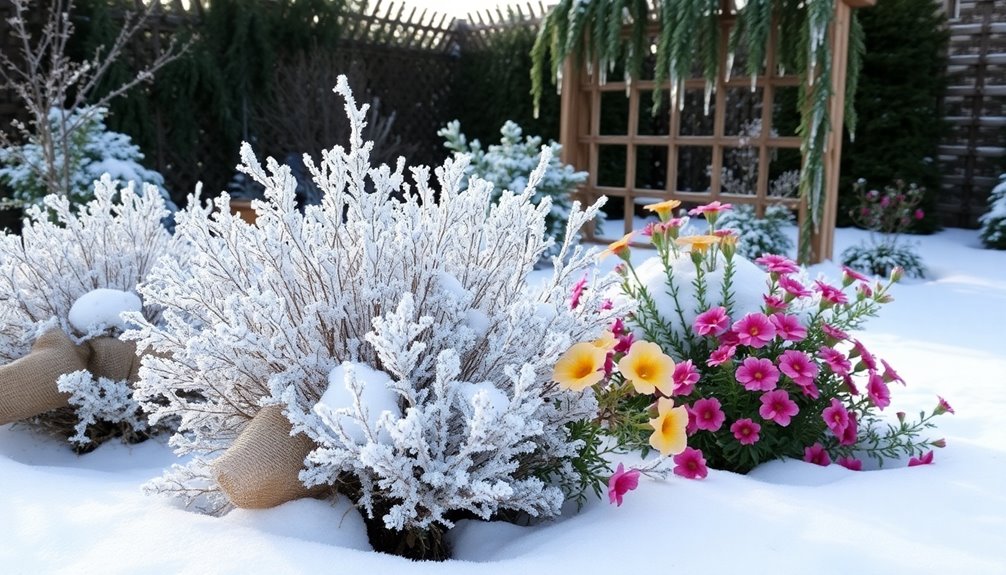
As you protect your garden with mulch, don't forget about the sensitive plants that need extra care during winter. These plants, such as tender perennials and young seedlings, require special attention to survive the cold months.
Start by identifying your most vulnerable plants. Consider wrapping them in burlap or using frost cloths to shield them from harsh winds and freezing temperatures.
If you have potted plants, move them to a more sheltered location or bring them indoors if possible. This can significantly reduce their exposure to the elements.
Additionally, you might want to create a protective barrier around your plants. Using stakes and a lightweight material, build a small enclosure that can trap heat during the day and keep the cold at bay at night.
Another effective method is to apply a thicker layer of mulch around these sensitive plants. This extra insulation can help retain soil warmth and protect roots from frost damage.
Regularly check on these plants throughout winter, ensuring they're not too dry. Using frost protection covers can further enhance their survival chances against extreme temperatures.
With a little proactive care, you'll give your sensitive plants the best chance to thrive come spring.
Pruning and Maintenance
During the winter months, you might think your garden is dormant, but it's actually a great time to focus on pruning and maintenance. Regular pruning helps promote healthy growth and prepares your plants for the spring season. Start by trimming away any dead or damaged branches on trees and shrubs. This not only enhances their appearance but also prevents diseases from spreading.
Here's a quick guide to help you with your pruning tasks:
| Plant Type | Best Time to Prune | Tools Needed |
|---|---|---|
| Deciduous Trees | Late winter | Pruning shears |
| Evergreens | Early spring | Loppers and saws |
| Flowering Shrubs | Late winter | Hand pruners |
| Perennials | Before new growth | Garden scissors |
In addition, don't forget to clean and maintain your tools. Sharp, clean tools make pruning easier and help prevent plant diseases. Spend some time inspecting your garden beds and removing any debris. Your garden will thank you come spring!
Soil Preparation Techniques
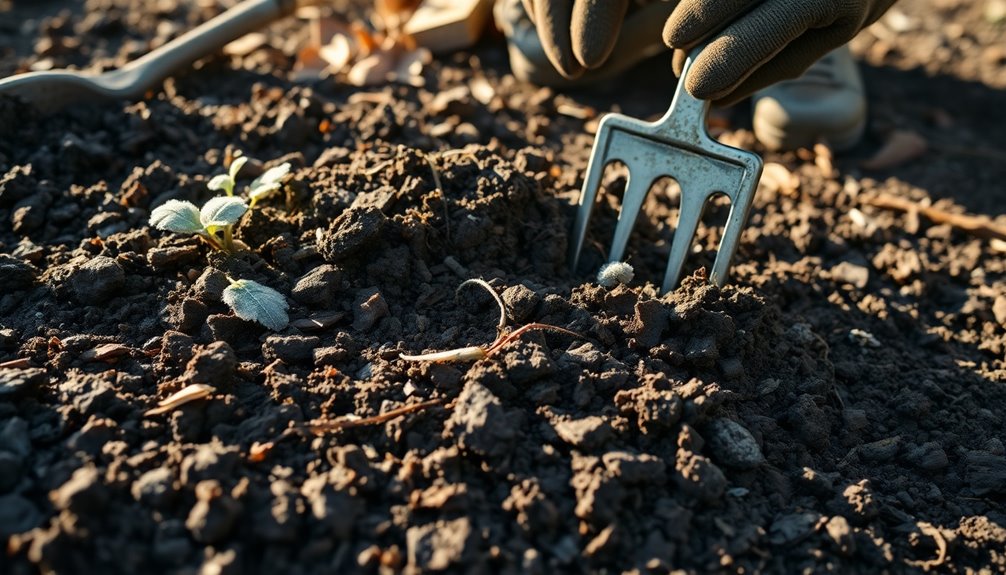
Preparing your soil in winter sets the stage for a thriving garden come spring. Start by clearing away any debris, such as dead leaves or weeds, which can harbor pests or diseases.
Next, test your soil's pH levels and nutrient content. You can use a home testing kit to determine if your soil needs amendments like lime or sulfur to adjust the pH.
Once you know what your soil needs, it's time to add organic matter. Incorporate well-rotted compost, aged manure, or leaf mold to improve soil structure and fertility. This not only enriches the soil but also enhances drainage and aeration.
If your garden has heavy clay or sandy soil, consider adding gypsum or sand to help with texture.
After you've amended the soil, turn it over with a spade or tiller to mix everything well. This aerates the soil, allowing beneficial microorganisms to thrive.
Finally, consider applying a layer of mulch to protect the soil from erosion and temperature fluctuations.
Watering Wisely
Watering wisely is crucial for maintaining a healthy winter garden. During colder months, plants need less water, but you still have to keep an eye on their hydration levels.
Start by checking the soil moisture before you water. Stick your finger about an inch into the soil; if it feels dry, it's time to water. Overwatering can lead to root rot, so be cautious.
Water your garden on warmer days when temperatures rise above freezing. Early morning is the best time, as it allows plants to absorb moisture before the chill sets in at night.
If you're using a hose, make sure to check for any ice buildup, as this could affect water flow.
Consider using mulch to retain moisture and regulate soil temperature. Mulch acts as insulation, protecting roots from extreme cold and reducing the need for frequent watering.
Lastly, pay attention to container plants. They often dry out faster than those in the ground, so monitor them closely.
Planning for Spring

As winter winds down, it's the perfect time to start planning for spring in your garden.
You want to ensure your garden thrives, so take this opportunity to outline your goals and strategies for the upcoming season.
Here are four essential steps to get you started:
1. Evaluate Your Space: Take a good look at your garden.
Identify areas that need improvement and decide whether you'd like to add new plants or rearrange existing ones.
2. Choose Your Plants: Research the best plants for your climate and soil type.
Consider incorporating a mix of flowers, vegetables, and herbs to create a diverse and vibrant garden.
3. Prepare Your Soil: Healthy soil is the foundation of a thriving garden.
Test your soil's pH and nutrient levels, and amend it with organic matter or fertilizers as needed.
4. Create a Planting Schedule: Timing is crucial.
Make a calendar of when to sow seeds or transplant seedlings, ensuring you maximize your garden's potential for growth.
Winter Pest Control
Battling pests during winter is crucial for protecting your garden's health. While it might seem like pests vanish with the cold, many remain dormant, ready to return when temperatures rise. Taking proactive measures now can prevent infestations later.
Here's a quick reference table to help you identify common winter pests:
| Pest | Control Method |
|---|---|
| Aphids | Spray with insecticidal soap |
| Spider Mites | Use neem oil or horticultural oil |
| Slugs | Set out beer traps or copper barriers |
| Whiteflies | Introduce beneficial insects like ladybugs |
| Root Weevils | Remove debris and use beneficial nematodes |
Regularly inspect your plants, focusing on the undersides of leaves and stems. If you spot any pests, act immediately to manage them. Additionally, consider applying organic mulch to create a barrier and improve soil health. By staying vigilant and using the right control methods, you can keep your garden thriving through the winter months and into spring. Remember, a healthy garden begins with effective winter pest management!
Utilizing Cover Crops
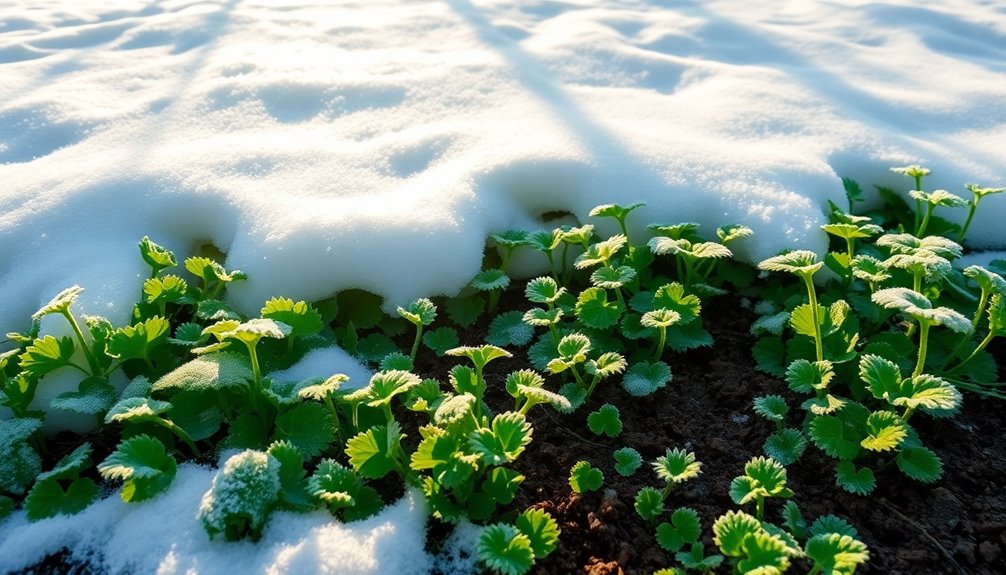
After managing winter pests, consider how cover crops can enhance your garden's resilience during the colder months.
Cover crops are an excellent way to protect and enrich your soil, preventing erosion and improving its structure. By planting these crops, you can create a thriving garden ecosystem that prepares your soil for spring planting.
Here are four key benefits of utilizing cover crops:
- Soil Health: Cover crops add organic matter, which improves soil structure and nutrient availability.
- Weed Suppression: By covering the ground, these crops outcompete weeds, reducing the need for herbicides.
- Nitrogen Fixation: Leguminous cover crops, like clover or vetch, can fix atmospheric nitrogen, enriching the soil for your next planting season.
- Erosion Control: Their root systems hold the soil in place, preventing erosion caused by wind and water.
Frequently Asked Questions
Can I Grow Vegetables Indoors During Winter?
Yes, you can grow vegetables indoors during winter. Choose suitable varieties, use proper lighting, and maintain appropriate temperatures. With the right care, you'll enjoy fresh produce even when it's cold outside. Happy gardening!
How Do I Store My Gardening Tools for Winter?
"An ounce of prevention is worth a pound of cure." To store your gardening tools for winter, clean them thoroughly, oil metal parts, and keep everything in a dry, organized space to prevent rust and damage.
What Are the Signs of Winter Plant Stress?
You'll notice winter plant stress through yellowing leaves, wilting, or stunted growth. If plants droop or show signs of frost damage, it's time to adjust your care routine to help them survive the cold.
How Often Should I Check on My Garden During Winter?
You should check on your garden every couple of weeks during winter. This way, you can spot any issues early, ensure plants stay healthy, and make adjustments as needed to protect them from the cold.
Can I Still Plant Bulbs in Winter?
While you might think winter's too cold for planting, you can still plant bulbs in late winter. Just ensure the ground isn't frozen, and choose hardy varieties to enjoy vibrant blooms come spring.
Conclusion
So, there you have it! If you want your garden to survive winter's icy grip, just follow these tips—or don't, and watch your plants throw a dramatic tantrum. It's your choice! But remember, while you're cozying up with hot cocoa, those poor greens are out there fighting for their lives. So, give 'em a hand, and they might just reward you with a flourishing spring. Or, you know, go ahead and let them perish for that rustic, wild look!

